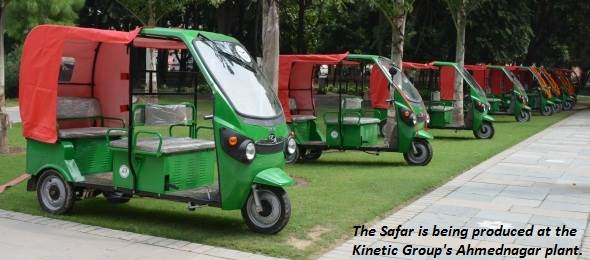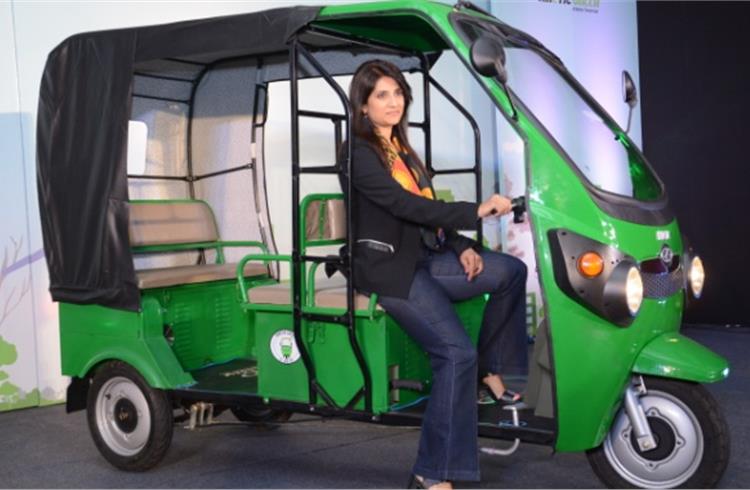‘We intend to ramp up our production to 3,000 vehicles per month by June 2016.’
The Kinetic Group’s Sulajja Firodia Motwani talks about the strategy behind the entry into the electric vehicle space and how it plans to ride the rising wave of green mobility in the country.
The Kinetic Group’s Sulajja Firodia Motwani talks about the strategy behind the entry into the electric vehicle space and how it plans to ride the rising wave of green mobility in the country. An interview by Sumantra B Barooah.
When did you first conceptualise the idea of floating Kinetic Green? What were the key drivers behind this move and how much has been the investment in this venture?
The Kinetic Group thrives on innovative products and bringing new advanced technology to customers in India and to commercialise it for mass production. Three years ago, we identified electric and hybrid vehicles as such a potential area for a new technology that can bring comfort, convenience and savings to customers.
We are extremely proud to have a product like the Kinetic Safar, our e-auto, as a torchbearer of our potential success in the field of electric vehicles. The total investments have been approximately Rs 30 crore.
Are there any lessons from other Kinetic ventures that you have implemented in the EV business? When do you expect it to break even?
The Kinetic Group’s core values and expertise lies in the areas of innovation and frugal engineering. The Kinetic Luna and Kinetic Honda have been great examples of these values where new technology has been brought within the reach of middle-class Indians by Kinetic.
We have built further on these core values. However, new principles of asset-light manufacturing and global sourcing will give an edge to this new business of green mobility and keep our break-evens low. Further, a completely new team has been created for this business and its vast potential. The breakeven is expected in the year 2016-17, considering the large order in hand and the current production level.
Kinetic Green has already bagged a Rs 400 crore order. Five years from now, what could be the turnover of Kinetic Green?
The turnover of Kinetic Green by 2020-21 will be upwards of Rs 1,000 crore, comprising of various models of electric and hybrid vehicles. At present, Kinetic Green is only focusing on the three-wheeler range of battery operated vehicles (BOVs).

How many vehicles have been sold by Kinetic Green so far? Apart from the 27,000 unit-strong order from Uttar Pradesh, has the company bagged any other orders?
The total number of electric vehicles sold till now is approximately 1,200 units, comprising of 200 buggies and 1,000 Kinetic Safar e-autos.
Other than the Uttar Pradesh order, we have bagged a 1,000 vehicle order in Delhi from the National Schedule Castes & Development Corporation as an employment scheme for SC / STs.
The Indian EV industry is still far away from the size first projected by NEMMP. The concept of EVs hasn’t been very well received. What is your outlook for the Indian EV industry?
I strongly believe that the EV industry is poised for strong growth in the coming years, and the success of the e-rickshaw segment proves that if products of the required performance and pricing combination are brought to the market, there are buyers for this technology.
Internationally, there are successes like Tesla, Leaf, Prius and the large EV industry in China that also substantiates the same. Customer acceptance is increasing and with the help of suitable government policy such as VAT waivers, RTO tax waivers and subsidy as proposed by the FAME India scheme, and resultant mass production will see more and more commercially viable products in this segment. This will further catapult customer adoption and growth.
What is now needed for all critical inputs of technological innovations by industry is government support to help in policy inputs and charging network creation, and financing support to move together to result in wide-scale adoption of EV technology. Something similar to what happened in the solar industry in the last five years. I am bullish that the projections of five million EVs per year sale in India will be achieved soon.
Do you feel that India can take a page or two from the EV growth story in China, or do you think these two markets are too different to share any lessons?
I won’t say the EV growth story will be as fast and big as China, as we lack the infrastructure of China and rural India has electricity availability problems. Hence, the growth of EVs in India is confined to metros, cities and towns. However, as opposed to China, where the EV industry grew due to government regulation forcing all two-wheelers in cities to be electric, I believe that in India the growth will come due to technological innovations by manufacturers, lower cost of technology in the coming years, and adequate government support that is being proposed.
What, according to you, could be done to create a market for EVs in India?
Continued government subsidy for the next few years, which will help in initial adoption of EVs by customers, and continued investment by manufacturers till such critical mass is achieved is required to create the initial market. Development of charging facilities at places like fuel pumps / fast-charging facilities all across the city, and financing support to customers of commercial electric vehicles like e-rickshaws by banks is also required.
Various parts of the country are witnessing a growing presence of vehicles from Chinese EV OEMs, which are more affordable than, say, a Kinetic EV. How do you plan to compete with the Chinese OEMs?
We don’t want to compete with these Chinese low-cost EVs , but develop the market as an organised player and technology leader with a more reliable and better engineered product and better sales/service and spares experience for the customers through our Kinetic Green dealerships. We also intend to develop new products with higher technological input and innovation.
What is the scope of growth you see for Kinetic Green? Given your group’s legacy in the two-wheeler business, do you plan to also offer electric two-wheelers?
Kinetic Green will focus on two business strategies – institutional sales and retail sales through a network of dealers providing sales /service and spares across India. Other than this, we plan to launch a range of products, from e-rickshaws to high-speed e-autos, both in the passenger and load carrier segments. We plan to cater to all the demands of EV segments in terms of usage and drivability.
What is the sales ratio of Kinetic Green’s portfolio of two- to 14-seaters?
Ninety percent of our buggy sales comprises six- and 14-seaters , and all the rest form the remaining 10 percent.
What is the installed production capacity of Kinetic Green’s production facility? How much of it is being utilised currently?
The installed capacity is of 4,000 vehicles per month and currently we are using 1,200 of the same. We intend to ramp up our production to 2,000 vehicles per month by May and 3,000 vehicles per month by June 2016.
Lastly, the EV and the superbike businesses are the latest ventures of the Kinetic Group. What is the current status of the Kinetic-Ikaros JV? Do you plan to expand into new areas?
All these businesses are in the early stages and with our focus on automotive systems, green energy and superbikes, we are well poised for rapid growth in the coming years.
RELATED ARTICLES
Setrans Mobility Booster Charging top-up 25% EV range in 15 minutes
Two enterprising tech-savvy entrepreneurs Rana Roshan Singh and Vivek Ummat of Noida, Uttar Pradesh-based start-up Setra...
'Our products are proudly 100% designed and made in India'
Creatara Mobility, a New Delhi based electric two-wheeler startup, claims to have tackled various challenges in making i...
'EVs have been around for a much smaller time than ICE, so best practices are still evolving'
EV OEMs and start-ups are under pressure to reduce production costs and bring them close to ICE counterparts. Vaibhav Ku...





 By Sumantra B Barooah
By Sumantra B Barooah
 22 Apr 2016
22 Apr 2016
 11611 Views
11611 Views





 Autocar Pro News Desk
Autocar Pro News Desk




